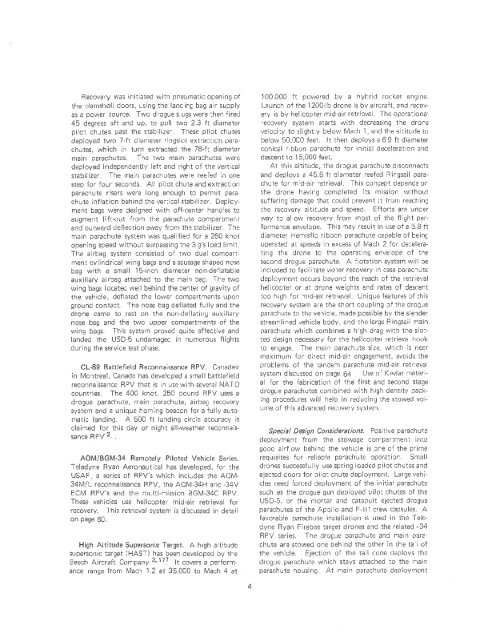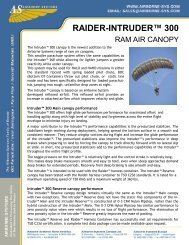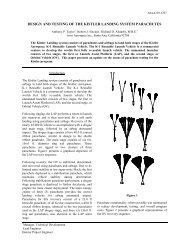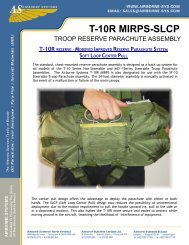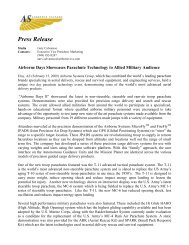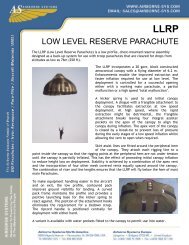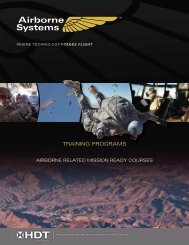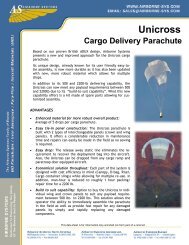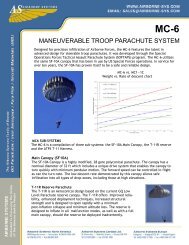"lfk f; \"A Lt. - Airborne Systems
"lfk f; \"A Lt. - Airborne Systems
"lfk f; \"A Lt. - Airborne Systems
Create successful ePaper yourself
Turn your PDF publications into a flip-book with our unique Google optimized e-Paper software.
. .<br />
Recovery was initiated with pneumatic opening of<br />
the clamshell doors. I.sing the lancin!; bag air supply<br />
as a power source. Two d. ogue $, ugs were -:hen fired<br />
45 degrees aft and up, to pull two 2. 3 ft diameter<br />
pilot chJtes past the stabilizE' These pilot chutes<br />
deployed two 7-ft diameter ringslol extracticn para-<br />
Cllutes. wh ich in turn extracted the 78.ft diameter<br />
main parachutes. The hNO main parachutes WErc<br />
deployed independently left and right of the vertical<br />
stabilizer The main parachutes were reeFed in one<br />
step for fou- seconds. All pilot chute and extraction<br />
paracnute risers were long enough to permit para,<br />
chute inflation behind the 'er:ical stabilizer, Deplcyment<br />
bags were designed with off-center hand'es to<br />
augment lift.out from the parachute compartrner,<br />
and outward deflection away fram the stabilizer, The<br />
main parachute system was qJalified for a 250 knot<br />
opening speed without surpassing the 3 g s loa:! limit,<br />
The airbag system consisted of two dual compartment<br />
cylindrical wing bags and a swsage shaped nose<br />
bag with a small 15- inch diameter non.deilatable<br />
C:w::iliary airbag attached to the nain oag. Ire two<br />
wing bags loeatee well behind the center of gravity of<br />
the vehide, deflated the lower compartments upon<br />
ground contact. The nose bag deflated fully and the<br />
drone came to rest on the nun.deflating auxiliary<br />
nose bag and the two upper compartments of the<br />
wing bags, This system proved quite effective and<br />
landed the USD.5 undamagec in numerous flights<br />
during the service test phase.<br />
CL.S9 Battlefield Reconnaissance RPV. C,madair<br />
in Montreal. Canada has developed a small battlefield<br />
reconnaissance RPV that is in use with several NATO<br />
countries , The 400 knot. 250 pound RPV uses a<br />
drogue parachuTe . rr.ain parachute, airbag recovery<br />
system and a unique homing beacon for a fully automatic<br />
landing, ;:. 500 tt la:1ding circle accuracy is<br />
claimed for t!Jis day or night all-weather reconnaissance<br />
RP\f2<br />
AQM!BGM-34 Remotely Piloted Vehicle Series.<br />
Teledyne Ryan Aeronautical has developed, fa" the<br />
USAF a series of RPV's which includes the AQM-<br />
34M!L reconnaissance RPV, the AQM-34H anc -34V<br />
ECM RPV' s and the mLlti-nission BGM.34C RPV,<br />
These vehicles use helicoPter mid-air retrieval for<br />
recovery. This retriev91 system is discussed in detail<br />
on page 60.<br />
High Altitude Supersonic Target. A high altitude<br />
supersonic target :HAST) has been developed by tre<br />
Beech Aircraft Company 3 177 It covers a perform.<br />
ance range from Mach 1 2 at 35.000 to Mach 4 at<br />
100.000 ft pOllvered by a hyl:rid rocket engine,<br />
Launch of the 120Q-lb drone is by aircraft, and recovery<br />
is by helicopter mid-air retrieval. Tho opora:iona<br />
ecovery system starts with decreasing tile drore<br />
veloci-:y to slight.y below Mach 1 . and the ai tilude to<br />
below 50 OCa feet. It then deploys a 69ft diameter<br />
conical r'bbon parachute for iifitizl deceleration and<br />
descent to 15 000 feet.<br />
At this altitude , the drDgl1e parachute disconnects<br />
and deploys a 45. 5 ft diameter reefed Rirgsail parachute<br />
for m 'd.air retrieval. This concept depends or<br />
the drone havirg completed its mission without<br />
suffering damage thelt cOlild prevent it from reaching<br />
the recovery altitude and speed, Efforts are uncer<br />
way to alow reCO'Jery frorn most of the fl ight performance<br />
envelope. This may result in use of a 5. 8 ft<br />
diameter Hemisflo riboon parachute capable of bein!=<br />
operated at speeds in excess of Mach 2 for decelerating<br />
the drone to the oper9ting envelope of the<br />
second droguE parachute. A -:Iotation system will be<br />
included to facilitate water recovery In cElse parac1utE<br />
deployment occurs bayond the reach of the retrieval<br />
helicopter or at drone weights and rates of descent<br />
LOO high for mid-air retrieval Unique features ,:;f th is<br />
recovery system are the short coupling of the drog.<br />
parachU18 to the ve 1icle , made possible by the slender<br />
streamlined vehicle body, and the 16rge Ringsail main<br />
parachute which combines a h' gh drag with the SiD:.<br />
ted design necessary for the helicopter retrieva hook<br />
10 engage, The main parachJte size, which is neer<br />
maximum tor direct mid-air engagement. avoids the<br />
protlems of the tandem parachute mid-air retrieval<br />
system discussed on page 64 Use 0 Kevlar material<br />
for the fabrication of the first and second stage<br />
drogue parachutes combined with high density packing<br />
procedures will help in reducing the stowed volume<br />
of this advanced recovery system.<br />
Speciaf De'ign Considerations. Positive parachut<br />
deployment from the stowage corrpartment into<br />
good airfow behind the vehicle is ::re of the prime<br />
requisites for reliable pa-Dehute opcrztior, Small<br />
drones successfully use spring loaded pilot chute. and<br />
ejected coors for oilo: chute deployment. Large vehi.<br />
cles need forced deployment of the in itial parachute<br />
such as the drogue gun deplo,;'ed pilot chutes of the<br />
USD-5, or the mortar and catapult ejecte:! drogue<br />
parachutes of the ApD/lo and F. II! crew capsules, A<br />
favorable parachute installation is used in the Tele.<br />
dvne Ryan Firebee target drones and the related -<br />
RPV series. The drosue pariJchutc and nain parE'<br />
chute are stowed one beh:nd the Dther in the ta i of<br />
tile vehicle, Ejection of the tail cone deplovs th9<br />
drogue parachute which stays attached to the fTain<br />
parachute housing. At main parachute deployment


